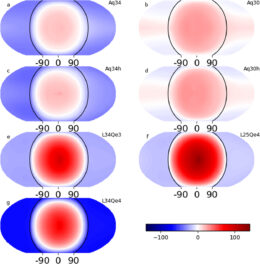Editor’s Note: In these last two weeks of 2023, we’ll be looking at a few selections that we haven’t yet discussed on AAS Nova from among the most-downloaded articles published in AAS journals this year. The usual posting schedule will resume in January.
Terminator Habitability: The Case for Limited Water Availability on M-dwarf Planets
Published March 2023
Main takeaway:
Ana Lobo (University of California, Irvine) and collaborators use global climate models to show that the abundance of water on a planet orbiting an M-dwarf star can determine the fraction of the planet’s surface that maintains habitable temperatures. The study focuses on whether temperatures along the terminator, the line that separates day and night, can remain habitable when daytime temperatures on a tidally locked planet become too hot. Perhaps counterintuitively, planets with more water can have less habitable area in this zone.
Why it’s interesting:
M dwarfs are the smallest, coolest, and most common type of star in our universe. Their cool temperatures result in close-in habitable zones, making for easy detection and characterization; rather than waiting for a once-annual transit of an Earth-like planet around a Sun-like star, habitable-zone M-dwarf planets zip around in days or weeks. However, many if not all of these planets are tidally locked, orbiting with one side permanently facing the host star and one side in permanent shadow. While both the day and night sides of these planets are unlikely to have habitable temperatures, the terminator could be livable.

Surface temperatures for aquaplanets (simulation names beginning with “Aq”) and land planets (names starting with “L”). The sub-stellar point is at the center of each image. Click to enlarge. [Lobo et al. 2023]
Why water plays an important role:
On a water-poor tidally locked planet, daytime temperatures can be extremely hot, and nighttime temperatures can be below freezing, leaving just the terminator at a comfortable temperature. Even when water-poor planets are close enough to their host stars that daytime temperatures are too hot to sustain life, there isn’t enough transport of the blazing daytime heat around the planet to render the terminator inhospitable. When more water is splashed in, resulting in an “aquaplanet,” the energy transport increases, extending the uninhabitable region to the terminator.
Citation
Ana H. Lobo et al 2023 ApJ 945 161. doi:10.3847/1538-4357/aca970

